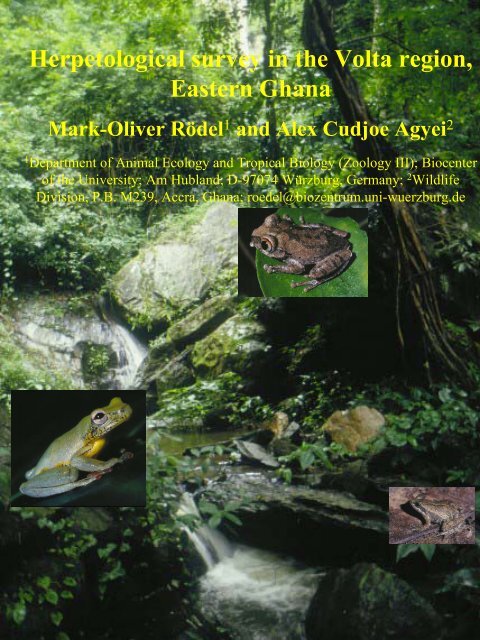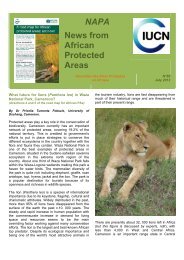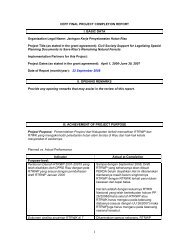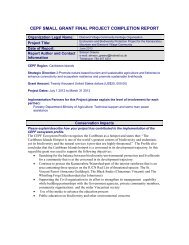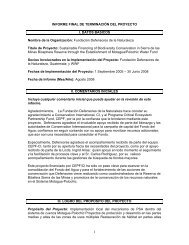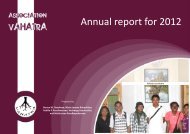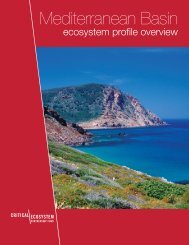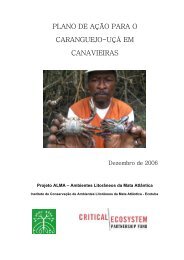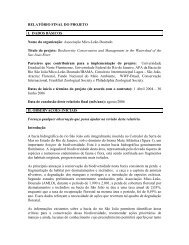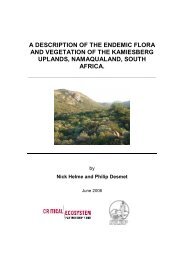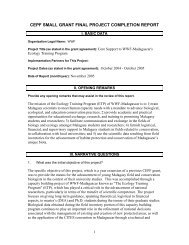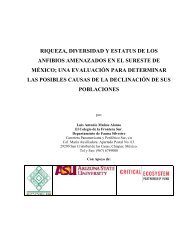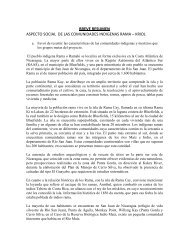Herpetological survey in the Volta region, Eastern Ghana - Critical ...
Herpetological survey in the Volta region, Eastern Ghana - Critical ...
Herpetological survey in the Volta region, Eastern Ghana - Critical ...
Create successful ePaper yourself
Turn your PDF publications into a flip-book with our unique Google optimized e-Paper software.
<strong>Herpetological</strong> <strong>survey</strong> <strong>in</strong> <strong>the</strong> <strong>Volta</strong> <strong>region</strong>,<br />
<strong>Eastern</strong> <strong>Ghana</strong><br />
Mark-Oliver Rödel 1 and Alex Cudjoe Agyei 2<br />
1 Department of Animal Ecology and Tropical Biology (Zoology III); Biocenter<br />
of <strong>the</strong> University; Am Hubland; D-97074 Würzburg, Germany; 2 Wildlife<br />
Division, P.B. M239, Accra, <strong>Ghana</strong>; roedel@biozentrum.uni-wuerzburg.de
<strong>Herpetological</strong> <strong>survey</strong> <strong>in</strong> <strong>the</strong> <strong>Volta</strong> <strong>region</strong>, <strong>Eastern</strong> <strong>Ghana</strong><br />
Mark-Oliver RÖDEL 1 and Alex Cudjoe AGYEI 2<br />
1 Department of Animal Ecology and Tropical Biology (Zoology III); Biocenter of <strong>the</strong> University; Am<br />
Hubland; D-97074 Würzburg, Germany; 2 Wildlife Division, P.B. M239, Accra, <strong>Ghana</strong>;<br />
roedel@biozentrum.uni-wuerzburg.de<br />
Contents<br />
1 Introduction ......................................................................................................................... 2<br />
2 Study sites ........................................................................................................................... 3<br />
2.1 Wli and Liati-Wote Waterfalls Region, Sou<strong>the</strong>ast of Hohoe....................................... 4<br />
2.2 Kyabobo National Park, Shiare and Nkwanta.............................................................. 4<br />
2.3 Apesokubi area and Nor<strong>the</strong>rn Lake <strong>Volta</strong>.................................................................... 4<br />
3 Sampl<strong>in</strong>g methods and sampl<strong>in</strong>g effort............................................................................... 5<br />
4 Sampl<strong>in</strong>g efficiency............................................................................................................. 6<br />
5 Species account: amphibians............................................................................................... 8<br />
6 Anuran community composition <strong>in</strong> different study sites <strong>in</strong> <strong>the</strong> <strong>Volta</strong> <strong>region</strong> ................... 12<br />
7 Comparison of <strong>the</strong> amphibian fauna from <strong>the</strong> <strong>Volta</strong> <strong>region</strong> with o<strong>the</strong>r West- and Central<br />
African <strong>region</strong>s..................................................................................................................... 14<br />
8 Status of amphibians endemic to <strong>the</strong> Togo Highlands and <strong>the</strong> Lower Gu<strong>in</strong>ean ra<strong>in</strong> forest<br />
and conservation status of <strong>the</strong> amphibian fauna of <strong>the</strong> <strong>Volta</strong> <strong>region</strong> ................................... 17<br />
9 Reptiles recorded <strong>in</strong> <strong>the</strong> <strong>Volta</strong> <strong>region</strong>................................................................................ 19<br />
10 Summary, conclusions and conservation implications ................................................... 20<br />
11 Acknowledgements ......................................................................................................... 21<br />
12 Literature ......................................................................................................................... 21<br />
13 Appendix ......................................................................................................................... 27
<strong>Herpetological</strong> Survey <strong>in</strong> <strong>the</strong> <strong>Volta</strong> <strong>region</strong>, <strong>Eastern</strong> <strong>Ghana</strong><br />
1 Introduction<br />
West African ra<strong>in</strong> forests are with<strong>in</strong> <strong>the</strong> 25 most important biodiversity hotspots of <strong>the</strong> world<br />
(Myers et al. 2000). They are highly threatened by logg<strong>in</strong>g, agriculture and <strong>in</strong>creas<strong>in</strong>g human<br />
populations (Bakarr et al. 2001). About 80 % of <strong>the</strong> Upper Gu<strong>in</strong>ean forests <strong>in</strong> Côte d'Ivoire<br />
have been destroyed dur<strong>in</strong>g <strong>the</strong> last 20 years (Rompay 1993, Chatela<strong>in</strong> et al. 1996). In <strong>Ghana</strong><br />
even less of <strong>the</strong> orig<strong>in</strong>al forest cover is still present.<br />
Despite <strong>the</strong> fact that West Africa was <strong>the</strong> target of herpetological <strong>in</strong>vestigations for<br />
more than a 100 years (e.g. Werner 1898, Ahl 1924 a,b), our present knowledge is still ra<strong>the</strong>r<br />
scanty (Hughes 1988 provides an overview on <strong>the</strong> history of herpetological <strong>in</strong>vestigations <strong>in</strong><br />
<strong>Ghana</strong>). For most of <strong>the</strong> described West African amphibians and reptiles biological data are<br />
still more or less anecdotal or completely lack<strong>in</strong>g. However, <strong>in</strong> <strong>the</strong> 1970's it was assumed that<br />
at least <strong>the</strong> species <strong>in</strong>ventory was nearly complete. Based on this assumption West Africa was<br />
looked upon as an area with a comparatively low diversity. Lamotte (1983) wrote that <strong>the</strong>re is<br />
no place <strong>in</strong> West Africa where more than 40 amphibian species live <strong>in</strong> sympatry. This seemed<br />
also to be true for <strong>the</strong> <strong>Eastern</strong> part of <strong>the</strong> Upper Gu<strong>in</strong>ean Forest block. Accord<strong>in</strong>g to an<br />
unpublished checklist, compiled by A. Schiøtz for <strong>the</strong> Conservation Priority Sett<strong>in</strong>g<br />
Workshop (From <strong>the</strong> Forest to <strong>the</strong> Sea: Biodiversity Connections from Gu<strong>in</strong>ea to <strong>Ghana</strong>,<br />
December 6.-10.1999 <strong>in</strong> Elm<strong>in</strong>a, <strong>Ghana</strong>), only 36 amphibian species have been recorded so<br />
far from this <strong>region</strong>.<br />
However, recent <strong>in</strong>vestigations <strong>in</strong> Côte d'Ivoire revealed anuran communities,<br />
compris<strong>in</strong>g more than 30 species, even <strong>in</strong> savanna habitats (Rödel 1998, 2000a, b, Rödel &<br />
Spieler 2000). Known forest communities comprise between 40 and 60 species (Rödel 2000b,<br />
Rödel & Ernst unpubl., compare Tab. 5 and Fig. 5). From West Africa seven new species<br />
have been described with<strong>in</strong> <strong>the</strong> last eight years and more new species still await description<br />
(Perret 1994; Lamotte & Ohler 1997; Rödel 1998; Rödel & Ernst 2000, <strong>in</strong> press; Rödel et al.<br />
<strong>in</strong> press a, b). Rema<strong>in</strong><strong>in</strong>g forest reserves <strong>in</strong> <strong>the</strong> Upper Gu<strong>in</strong>ea forest block probably comprise<br />
more than 60 sympatric amphibian species (Fig. 5). Diversity even exceeds most neotropical<br />
<strong>region</strong>s (Ernst & Rödel unpubl.). Similar species numbers are likely to occur <strong>in</strong> snakes<br />
(Hallermann & Rödel 1995, Rödel et al. 1995, 1999, Rödel & Mahsberg 2000, Ernst & Rödel<br />
<strong>in</strong> press).<br />
From <strong>the</strong> <strong>Eastern</strong> part of <strong>the</strong> Upper Gu<strong>in</strong>ean forests only n<strong>in</strong>e endemic amphibian<br />
species have been described so far. The last more extensive field work <strong>in</strong> this <strong>region</strong> date back<br />
to <strong>the</strong> early 1960's (Schiøtz 1964a, b, 1967). More recent <strong>in</strong>vestigations <strong>in</strong> <strong>Ghana</strong> were not<br />
focused on forest habitats or were not undertaken with special emphasis on amphibians<br />
2
<strong>Herpetological</strong> Survey <strong>in</strong> <strong>the</strong> <strong>Volta</strong> <strong>region</strong>, <strong>Eastern</strong> <strong>Ghana</strong><br />
(Hoogmoed 1979, 1980 a-g; Hughes 1988). Judg<strong>in</strong>g from our results <strong>in</strong> Côte d'Ivoire <strong>the</strong><br />
herpetofauna of <strong>Ghana</strong> is probably only very <strong>in</strong>completely known. This especially concerns<br />
<strong>the</strong> almost neglected Togo highlands <strong>in</strong> <strong>the</strong> east of <strong>the</strong> country. For this reason A. Schiøtz and<br />
M.-O. Rödel def<strong>in</strong>ed <strong>the</strong> eastern Ghanian forests as an area with an exceptionally high priority<br />
level for rapid assessment dur<strong>in</strong>g <strong>the</strong> Conservation Priority Sett<strong>in</strong>g Workshop <strong>in</strong> <strong>Ghana</strong><br />
(Bakarr et al. 2001).<br />
2 Study sites<br />
All study sites were situated with<strong>in</strong> <strong>the</strong> zone of humid semi-deciduous forest and dense<br />
deciduous forest of <strong>the</strong> Upper Gu<strong>in</strong>ean Forest Block between Lake <strong>Volta</strong> and <strong>the</strong> Togo border<br />
(Fig. 1, 4). Climatologically this area is part of <strong>the</strong> wet semi-equatorial <strong>region</strong>, geologically it<br />
belongs to <strong>the</strong> <strong>Volta</strong>ian Bas<strong>in</strong> (Buem series and Togo series, Frempong 1995). A short<br />
characterization of all three <strong>region</strong>s and description of <strong>the</strong> respective habitats (habitat # <strong>in</strong><br />
paren<strong>the</strong>ses, compare Tab. 1) <strong>in</strong>vestigated are given below. The exact geographic positions<br />
are given <strong>in</strong> appendix A1.<br />
Fig. 1: Vegetation zones of West Africa, study area circled <strong>in</strong> red. 1 = ra<strong>in</strong> forest, 2 = humid semideciduous<br />
forest, 3 = dense deciduous forest (Gu<strong>in</strong>ea Zone), 4 = open savanna woodland (Sudan<br />
Zone), 5 = Sahel Zone.<br />
3
<strong>Herpetological</strong> Survey <strong>in</strong> <strong>the</strong> <strong>Volta</strong> <strong>region</strong>, <strong>Eastern</strong> <strong>Ghana</strong><br />
2.1 Wli and Liati-Wote Waterfalls Region, Sou<strong>the</strong>ast of Hohoe<br />
The geological underground comprises quartzite, shale and phyllite. Mean annual<br />
precipitation is 1650 mm (Frempong 1995).<br />
Wli Waterfall: Escarpment close to <strong>the</strong> Togo border, steep slopes with scattered forest<br />
remnants and plantations (11); fast flow<strong>in</strong>g mounta<strong>in</strong> creek <strong>in</strong> <strong>the</strong> valley (3); bordered by ra<strong>in</strong><br />
forest remnants (10); open areas with scattered lower trees (3); heavily vegetated swamps<br />
fully exposed to sun, forest fragments nearby, small shrubs (2, 12); shallow pond heavily<br />
vegetated, part of large flooded area, shrubs and larger herbs at pond border (5); plantations<br />
and secondary forest (9); degraded forest between <strong>the</strong> NCRC nursery and pond (6); dense<br />
under storey, open canopy, rocky mounta<strong>in</strong> creek, waterfall (4); small pond <strong>in</strong> dry bed of<br />
small creek (7); way through forest remnants, dead tree with water hole (8).<br />
Liati Wote Waterfall (=Tagbo Fall): valley with fast runn<strong>in</strong>g rocky creek, waterfall, cacao<br />
plantations and forest remnants (35); village, artificial pond, rice fields, surround<strong>in</strong>g of village<br />
resembles humid savanna (36).<br />
2.2 Kyabobo National Park, Shiare and Nkwanta<br />
The underground is formed by quartzite, shale and phyllite. Mean annual precipitation is 1400<br />
mm (Frempong 1995).<br />
Nkwanta: road ditches, garden (13); rice fields East of Nkwanta, puddles on dirt road (14),<br />
rice fields north of Nkwanta, small ponds (15).<br />
Kyabobo NP: way <strong>in</strong>to park, hilly landscape, character of tree savanna, on <strong>the</strong> slopes dense<br />
but low forest, <strong>in</strong> <strong>the</strong> valley corn, cassava and banana plantations (16); <strong>in</strong> <strong>the</strong> NP fast flow<strong>in</strong>g<br />
rocky creek, very hilly landscape, forest with s<strong>in</strong>gle larger trees (up to 40 m) on steep slopes,<br />
primary forest on bottom of valley, on hill tops forest changes <strong>in</strong>to savanna (17, 18).<br />
Shiare: dirt road with shallow puddles (33); plantations, fast flow<strong>in</strong>g creek (water polluted<br />
with sewage run-off from village), partly deep water, rocks, rapids, forest remnants with<br />
dense under storey (32); small rocky creek, bank with dense vegetation, gallery forest, partly<br />
high forest, bordered by plantations, (cassava, bananas), on hill-top savanna forest (34).<br />
2.3 Apesokubi area and Nor<strong>the</strong>rn Lake <strong>Volta</strong><br />
The Upper Precambrian underground comprises shale sandstone, arhose and lava. Mean<br />
annual precipitation is 1524 mm (Frempong 1995).<br />
4
<strong>Herpetological</strong> Survey <strong>in</strong> <strong>the</strong> <strong>Volta</strong> <strong>region</strong>, <strong>Eastern</strong> <strong>Ghana</strong><br />
Apesokubi: West of town, dried up pond, bank with herbs and shrubs, degraded forest remnant<br />
(19, 20); puddles on dirt road, bordered by dense shrubs and degraded forest and cacao<br />
plantations (21, 25, 26); rice fields (22, 24); shallow, slow runn<strong>in</strong>g muddy creek, secondary<br />
forest, s<strong>in</strong>gle emergent trees, few puddles <strong>in</strong> a rice field (23); South of town, large pond,<br />
partly heavily vegetated, float<strong>in</strong>g herbs, secondary forest, plantations (27); small pond, bank<br />
vegetated with herbs and shrubs (28); two shallow ponds between dirt road and secondary<br />
forest (29).<br />
Katanka and bank of Lake <strong>Volta</strong>: small puddle without vegetation, surrounded by savanna<br />
(30); <strong>Volta</strong> bank without vegetation, Borassus palm savanna (31).<br />
Tab. 1: Investigated <strong>region</strong>s, <strong>the</strong> respective habitat numbers and time spent (m/h) look<strong>in</strong>g for<br />
amphibians <strong>in</strong> every <strong>region</strong>.<br />
Region habitat # m/h<br />
Wli and Liati Wote Waterfalls 1, 2, 3, 4, 5, 6, 7, 8, 9, 10, 11, 12, 35, 36 94,25<br />
Kyabobo NP, Shiare, Nkwanta 13, 14, 15, 16, 17, 18, 32, 33, 34 75,75<br />
Apesokubi, <strong>Volta</strong> 19, 20, 21, 22, 23, 24, 25, 26, 27, 28, 29, 30, 31 37,5<br />
3 Sampl<strong>in</strong>g methods and sampl<strong>in</strong>g effort<br />
The sampl<strong>in</strong>g method for amphibians <strong>in</strong> all areas <strong>in</strong>vestigated was <strong>the</strong> same and consisted of<br />
opportunistic visual and acoustical monitor<strong>in</strong>g of all present habitat types (Heyer et al. 1993).<br />
Sampl<strong>in</strong>g was done dur<strong>in</strong>g day and night time, preferably after ra<strong>in</strong>fall when possible. With<br />
this k<strong>in</strong>d of sampl<strong>in</strong>g design, only qualitative and semi quantitative data can be obta<strong>in</strong>ed. For<br />
exact quantitative data mark-recapture experiments along standardized transects or on def<strong>in</strong>ite<br />
plots would have been necessary. S<strong>in</strong>ce this <strong>survey</strong> allowed only three to five days for every<br />
<strong>region</strong> <strong>in</strong>vestigated, time was not sufficient to employ <strong>the</strong>se methods. To evaluate our<br />
sampl<strong>in</strong>g efficiency we measured <strong>the</strong> time, <strong>in</strong> men hours (m/h) look<strong>in</strong>g for amphibians at a<br />
certa<strong>in</strong> place. More time for <strong>in</strong>vestigation was spent <strong>in</strong> complex and larger habitats, than <strong>in</strong><br />
small and uniform ones. Tab. 1 and 2 summarize sampl<strong>in</strong>g time and date for all habitats<br />
<strong>in</strong>vestigated. Reptiles were recorded opportunistically while monitor<strong>in</strong>g amphibians. A few<br />
voucher specimens, from both amphibians and reptiles, were collected. All vouchers were<br />
anes<strong>the</strong>tized and killed <strong>in</strong> a chlorbunatol solution and <strong>the</strong>reafter preserved <strong>in</strong> 70 % ethanol.<br />
Vouchers will be deposited <strong>in</strong> <strong>the</strong> collection of <strong>the</strong> Staatliches Museum für Naturkunde<br />
Stuttgart.<br />
5
<strong>Herpetological</strong> Survey <strong>in</strong> <strong>the</strong> <strong>Volta</strong> <strong>region</strong>, <strong>Eastern</strong> <strong>Ghana</strong><br />
Tab. 2: Habitats and sampl<strong>in</strong>g effort (m/h), geographic position of habitats is given <strong>in</strong> appendix A1,<br />
for habitat description see study sites.<br />
habitat # man/hours date habitat # man/hours date<br />
1 14 10.-13.8.2001 19 3 25.08.2001<br />
2 11 10.-12.08.2001 20 10 25.-28.08.2001<br />
3 3 10.08.2001 21 2 26.08.2001<br />
4 16 11.08.2001 22 2 26.08.2001<br />
5 12 12.08.2001 23 3 26.08.2001<br />
6 3 12.08.2001 24 0.5 26.08.2001<br />
7 0.3 12.08.2001 25 0.5 26.08.2001<br />
8 9 11.-14.08.2001 26 1.5 26.08.2001<br />
9 8 12.08.2001 27 7 27.08.2001<br />
10 4 13.08.2001 28 3 27.08.2001<br />
11 5 13.08.2001 29 3.5 27.08.2001<br />
12 5 13.-14.08.2001 30 0.5 28.08.2001<br />
13 7.5 15.-20.08.2001 31 2 28.08.2001<br />
14 0.25 20.08.2001 32 13 22.08.2001<br />
15 3 20.08.2001 33 14 21.-24.08.2001<br />
16 2 16.08.2001 34 20 21.-23.08.2001<br />
17 5 16.-18.08.2001 35 3.5 29.08.2001<br />
18 11 16.-18.08.2001 36 0.5 29.08.2001<br />
4 Sampl<strong>in</strong>g efficiency<br />
Dur<strong>in</strong>g <strong>the</strong> whole <strong>in</strong>vestigation 32-34 amphibian species were recorded (DNA analyzes to<br />
clarify <strong>the</strong> taxonomic position of two doubtful "species" are <strong>in</strong> progress). A species<br />
accumulation curve, shows how many new species were added each day (Fig. 2). The<br />
cont<strong>in</strong>ued <strong>in</strong>crease of <strong>the</strong> curve's slope <strong>in</strong>dicates that, dur<strong>in</strong>g <strong>the</strong> <strong>survey</strong> period, we most likely<br />
did not record all amphibian species liv<strong>in</strong>g with<strong>in</strong> <strong>the</strong> <strong>Volta</strong> <strong>region</strong>.<br />
Based on <strong>the</strong> assumption that sampl<strong>in</strong>g effort was <strong>the</strong> same for every habitat we<br />
calculated <strong>the</strong> approximate total number of amphibian species liv<strong>in</strong>g <strong>in</strong> <strong>the</strong> <strong>Volta</strong> <strong>region</strong>.<br />
Because we had no quantitative data available, we used <strong>the</strong> Jack-knife 1 estimator, based on<br />
presence/absence data for all habitats (program: BiodivPro from <strong>the</strong> Natural History Museum<br />
London). This procedures <strong>in</strong>dicated that approximately 46 amphibian species live with<strong>in</strong> <strong>the</strong><br />
<strong>Volta</strong> <strong>region</strong> (Fig. 3). We thus recorded about 74 % of <strong>the</strong> <strong>region</strong>al amphibian fauna.<br />
6
species number<br />
35<br />
30<br />
25<br />
20<br />
15<br />
10<br />
5<br />
0<br />
10.08.2001<br />
<strong>Herpetological</strong> Survey <strong>in</strong> <strong>the</strong> <strong>Volta</strong> <strong>region</strong>, <strong>Eastern</strong> <strong>Ghana</strong><br />
11.08.2001<br />
12.08.2001<br />
13.08.2001<br />
14.08.2001<br />
15.08.2001<br />
16.08.2001<br />
17.08.2001<br />
18.08.2001<br />
Fig. 2: Species accumulation curve of amphibians registered <strong>in</strong> <strong>the</strong> <strong>Volta</strong> <strong>region</strong> from 10-29 August<br />
2001.<br />
Jack-knife 1<br />
50<br />
40<br />
30<br />
20<br />
10<br />
0<br />
Species Richness<br />
0 10 20 30 40<br />
Pooled Samples<br />
Fig. 3: Estimation of amphibian species number <strong>in</strong> <strong>the</strong> <strong>Volta</strong> <strong>region</strong>. Approximately 46 amphibian<br />
species may be liv<strong>in</strong>g <strong>in</strong> that area.<br />
19.08.2001<br />
20.08.2001<br />
21.08.2001<br />
22.08.2001<br />
23.08.2001<br />
24.08.2001<br />
25.08.2001<br />
26.08.2001<br />
27.08.2001<br />
28.08.2001<br />
29.08.2001<br />
7
<strong>Herpetological</strong> Survey <strong>in</strong> <strong>the</strong> <strong>Volta</strong> <strong>region</strong>, <strong>Eastern</strong> <strong>Ghana</strong><br />
5 Species account: amphibians<br />
Below we give a short description of <strong>the</strong> distribution and habitat preferences of <strong>the</strong> recorded<br />
amphibian species, <strong>in</strong>clud<strong>in</strong>g possible conservation status. More detailed descriptions are<br />
provided by Schiøtz (1967) and Rödel (2000a). Nomenclature follows Schiøtz (1967), Rödel<br />
(2000a) and Frost (2001, http://research.amnh.org/herpetology/amphibia/<strong>in</strong>dex.html). Species<br />
names are followed by a quotation of those habitats were <strong>the</strong> respective species was recorded<br />
(compare study sites and Tab. A2).<br />
Family Pipidae<br />
Silurana tropicalis GRAY, 1864 (5): A widespread aquatic, West African forest frog that takes<br />
advantage of spread<strong>in</strong>g from gallery forests <strong>in</strong>to <strong>the</strong> savanna zone. Not threatened.<br />
Family Bufonidae<br />
Bufo maculatus HALLOWELL, 1885 "1854"(5, 9, 10, 13, 20, 32, 33, 36): Very common and<br />
widespread African toad, that <strong>in</strong>habits all habitat types from degraded forests to moist<br />
savannas. Only very dry savannas and primary ra<strong>in</strong> forest are avoided. Not threatened.<br />
Bufo regularis REUSS, 1833 (1, 4, 6, 9, 10, 13, 20, 31, 33, 36): Very common West and<br />
Central African toad that is especially abundant around human settlements. Not threatened.<br />
Family Hemisotidae<br />
Hemisus sp. (1, 5): Burrow<strong>in</strong>g frog and <strong>the</strong>refore rarely encountered. The collected specimens<br />
occurred close to forest remnants but are clearly different from forest dwell<strong>in</strong>g Hemisus<br />
gu<strong>in</strong>eensis. As <strong>the</strong>y also show some differences to <strong>the</strong> savanna dwell<strong>in</strong>g Hemisus marmoratus<br />
<strong>the</strong> taxonomic status of <strong>the</strong>se frogs rema<strong>in</strong>s doubtful. DNA analyses are <strong>in</strong> progress (Rödel &<br />
Kosuch <strong>in</strong> prep.). Status uncerta<strong>in</strong>.<br />
Family Ranidae<br />
Hoplobatrachus occipitalis GÜNTHER, 1859 (4, 5, 10, 12, 15, 20, 26, 29, 30, 33, 35):<br />
Extremely common, aquatic savanna species that penetrates <strong>the</strong> forest zone <strong>in</strong> disturbed areas.<br />
Not threatened <strong>in</strong> most areas, possibly threatened <strong>in</strong> o<strong>the</strong>rs by human consumption.<br />
Amnirana albolabris (HALLOWELL, 1856) (3, 7, 23, 25, 27, 32): Common West- and Central<br />
African forest frog that <strong>in</strong>habits primary and degraded forests close to rivers. Not threatened.<br />
8
<strong>Herpetological</strong> Survey <strong>in</strong> <strong>the</strong> <strong>Volta</strong> <strong>region</strong>, <strong>Eastern</strong> <strong>Ghana</strong><br />
Amnirana galamensis (DUMÉRIL & BIBRON, 1844)(15): Common, but not abundant West<br />
African savanna species. Status uncerta<strong>in</strong>.<br />
Ptychadena aequiplicata (WERNER, 1898)(12): Widespread but never abundant West and<br />
Central African forest frog. With few exceptions <strong>in</strong>habits only primary forest. Possibly<br />
vulnerable due to habitat destruction.<br />
Ptychadena bibroni (HALLOWELL, 1845)(1, 5, 15, 33): Very common West African <strong>in</strong>habitant<br />
of degraded forests and moist savannas. Not threatened.<br />
Ptychadena mascareniensis (DUMÉRIL & BIBRON, 1841)(24, 28): A taxonomically difficult<br />
species complex that occurs <strong>in</strong> almost all habitats throughout Africa and Madagascar.<br />
Taxonomy is not sufficiently settled to estimate possible threats, but West African forest<br />
species might be restricted to comparatively small areas.<br />
Ptychadena oxyrhynchus (SMITH, 1849)(33, 34): Widespread and common African savanna<br />
frog. Not threatened.<br />
Ptychadena pumilio (BOULENGER, 1920)(15, 20, 31): Widespread and very common African<br />
frog that <strong>in</strong>habits degraded forests and moist savannas all over Africa south of <strong>the</strong> Sahara.<br />
Might comprise several species. Not threatened.<br />
Ptychadena schubotzi (STERNFELD, 1917)(29, 30, 36): Common West and Central African<br />
savanna species. Not threatened.<br />
Phrynobatrachus accraensis AHL, 1923 (3, 4, 5, 8, 12, 13, 15, 21, 23, 27, 29, 33): Extremely<br />
common and widespread West African savanna species that <strong>in</strong>habits also degraded forest<br />
areas. New DNA analyses proved this species to be conspecific with Phrynobatrachus<br />
latifrons, and <strong>the</strong>rewith also with <strong>the</strong> <strong>Volta</strong> "endemic" Phrynobatrachus latifrons togoensis<br />
Ahl, 1924 (Rödel & Kosuch unpubl.). Not threatened.<br />
Phrynobatrachus calcaratus (PETERS, 1863)(17, 10, 18, 33): Widespread West and central<br />
African forest frog. Not threatened.<br />
9
<strong>Herpetological</strong> Survey <strong>in</strong> <strong>the</strong> <strong>Volta</strong> <strong>region</strong>, <strong>Eastern</strong> <strong>Ghana</strong><br />
Phrynobatrachus aff. calcaratus (8): Very similar to typical Phrynobatrachus calcaratus,<br />
however differs by smaller size and different coloration. We have collected <strong>the</strong>se frogs <strong>in</strong> a<br />
water filled tree hole where <strong>the</strong>y also reproduced. This k<strong>in</strong>d of breed<strong>in</strong>g behavior is ei<strong>the</strong>r<br />
unknown for <strong>the</strong> species or might speak <strong>in</strong> favor of specific dist<strong>in</strong>ctiveness of our voucher<br />
specimens to Phrynobatrachus calcaratus. DNA analyses will clarify <strong>the</strong> taxonomic status of<br />
<strong>the</strong>se frogs. If this proves to be an undescribed species, it might be threatened due to a very<br />
small range.<br />
Phrynobatrachus francisci BOULENGER, 1912 (31): Widespread and common West African<br />
savanna frog. Not threatened.<br />
Phrynobatrachus natalensis (SMITH, 1849)(15, 20, 33, 34): Widespread African savanna frog.<br />
Not threatened.<br />
Phrynobatrachus plicatus (GÜNTHER, 1859 "1858")(12): Widespread West African forest<br />
frog. Not threatened.<br />
Family Arthroleptidae<br />
Arthroleptis sp. (1, 4, 6, 11, 16, 17, 18, 20, 23, 26, 33, 34, 35): Very common frog <strong>in</strong> degraded<br />
forest throughout <strong>the</strong> <strong>Volta</strong> <strong>region</strong>. Taxonomic status uncerta<strong>in</strong>. Obviously different from<br />
species from <strong>the</strong> Western part of <strong>the</strong> Upper Gu<strong>in</strong>ean Forest Block because it has a completely<br />
different advertisement call. Coloration and morphology are identical to Arthroleptis<br />
variabilis, A. crusculum and A. poecilonotus. Frogs from <strong>the</strong> <strong>Volta</strong> <strong>region</strong> seem to be smaller.<br />
It might be ei<strong>the</strong>r A. breviceps, orig<strong>in</strong>ally described by Ahl (1924) from a locality <strong>in</strong> nearby<br />
Togo (Misahöhe) and never recorded s<strong>in</strong>ce its first description <strong>in</strong> 1923, or Schoutedenella<br />
zimmeri, described by Ahl (1925) from Accra. However, as frogs of <strong>the</strong> genera Arthroleptis<br />
and Schoutendenella (it is unclear whe<strong>the</strong>r both of <strong>the</strong>se genera are valid or Schoutedenella is<br />
simply a subgenus of Arthroleptis) comprise <strong>the</strong> taxonomically most difficult African frogs<br />
and morphological comparison with museum vouchers is <strong>in</strong>sufficient for determ<strong>in</strong>ation, <strong>the</strong><br />
taxonomic status of our vouchers rema<strong>in</strong> unclear. Status uncerta<strong>in</strong>, but based on its habitat<br />
preference most probably not threatened.<br />
10
<strong>Herpetological</strong> Survey <strong>in</strong> <strong>the</strong> <strong>Volta</strong> <strong>region</strong>, <strong>Eastern</strong> <strong>Ghana</strong><br />
Family Hyperoliidae<br />
Leptopelis viridis (GÜNTHER, 1868)(13, 15): Widespread West African savanna frog. Not<br />
threatened.<br />
Leptopelis hyloides (BOULENGER, 1906)(1, 5, 10, 12, 20, 23, 32, 33, 35): Widespread West<br />
African forest species. Inhabits primary and degraded forests. At all sites very common. Not<br />
threatened.<br />
Hyperolius baumanni AHL, 1931 (2, 5, 12, 20, 22, 23, 25, 27, 28, 29): Endemic frog of<br />
<strong>Eastern</strong> <strong>Ghana</strong> and <strong>the</strong> Togo highlands. Inhabits degraded forests and forest edges.<br />
Hyperolius cf. viridigulosus SCHIØTZ, 1967 (34): Status of vouchers uncerta<strong>in</strong> (DNA analyses<br />
<strong>in</strong> prep.). Most probably H. viridigulosus that is a forest species endemic to Côte d'Ivoire and<br />
Western <strong>Ghana</strong>. Our records <strong>the</strong>refore are ei<strong>the</strong>r a first record for <strong>Eastern</strong> <strong>Ghana</strong> or speak <strong>in</strong><br />
favor of an undescribed species. Possibly vulnerable due to deforestation.<br />
Hyperolius cf. picturatus PETERS, 1875 (18): Not previously recorded from <strong>Eastern</strong> <strong>Ghana</strong>.<br />
Ei<strong>the</strong>r new record or new taxa (DNA analyses <strong>in</strong> prep.). Habitat preference exactly <strong>the</strong> same<br />
as Ivorian H. picturatus from Taï and Mont Sangbé National Parks (Rödel unpubl.). Status<br />
uncerta<strong>in</strong>.<br />
Hyperolius cf. torrentis SCHIØTZ, 1967 (32): Status of vouchers uncerta<strong>in</strong> (DNA analyses <strong>in</strong><br />
prep.). Most probably H. torrentis that is a forest species endemic to <strong>Eastern</strong> <strong>Ghana</strong> and<br />
adjacent Togo. Possibly vulnerable due to forest destruction.<br />
Hyperolius concolor RAPP, 1842 (2, 3, 5, 6, 12, 15, 19, 20, 22, 23, 26, 27, 28, 29):<br />
Widespread West and Central African frog that lives <strong>in</strong> degraded forest habitats as well as <strong>in</strong><br />
very moist savanna areas. Not threatened.<br />
Hyperolius fusciventris burtoni SCHIØTZ, 1967 (5, 12, 27, 28): Widespread West African<br />
forest frog. The subspecies H. f. burtoni is endemic to <strong>the</strong> <strong>Eastern</strong> part of <strong>the</strong> Upper Gu<strong>in</strong>ean<br />
Forest Block. Not threatened.<br />
11
<strong>Herpetological</strong> Survey <strong>in</strong> <strong>the</strong> <strong>Volta</strong> <strong>region</strong>, <strong>Eastern</strong> <strong>Ghana</strong><br />
Hyperolius nasutus GÜNTHER, 1864 (15): Widespread frog that lives mostly <strong>in</strong> drier savanna<br />
areas all over Africa South of <strong>the</strong> Sahara. Not threatened.<br />
Hyperolius nitidulus PETERS, 1875 (14, 15): Very common and widespread West African<br />
savanna frog. Not threatened.<br />
Hyperolius sp. (5): Taxonomic status uncerta<strong>in</strong>. If it is an undescribed species, possibly<br />
threatened due to very small range.<br />
Afrixalus dorsalis (PETERS, 1875)(2, 4, 5, 12, 19, 27, 28): Widespread and common West and<br />
Central African forest frog that <strong>in</strong>habits degraded forests <strong>in</strong> <strong>the</strong> forest zone and gallery forests<br />
<strong>in</strong> <strong>the</strong> savanna zone. Not threatened.<br />
Afrixalus vittiger (PETERS, 1876)(14, 15): Widespread West African savanna species. Not<br />
threatened.<br />
Kass<strong>in</strong>a senegalensis (DUMÉRIL & BIBRON, 1841)(14): Widespread African savanna frog. Not<br />
threatened.<br />
6 Anuran community composition <strong>in</strong> different study sites <strong>in</strong> <strong>the</strong> <strong>Volta</strong> <strong>region</strong><br />
Table 3 provides an overview of all amphibian species recorded by us <strong>in</strong> <strong>the</strong> <strong>Volta</strong> <strong>region</strong>,<br />
with respect to <strong>the</strong> three areas <strong>in</strong>vestigated. The table also provides <strong>in</strong>formation on which<br />
pr<strong>in</strong>cipal habitat types were ma<strong>in</strong>ly selected by a certa<strong>in</strong> species. Forest species are those that<br />
need more or less closed forest, both degraded and primary forest. The def<strong>in</strong>ition of farmbush<br />
species is based on Schiøtz (1967). It comprises all amphibian species that live with<strong>in</strong> <strong>the</strong><br />
former forest zone, but are not dependent on closed forest canopy and are not able to survive<br />
with<strong>in</strong> true savanna habitats. Normally <strong>the</strong>se species can be found at forest edges, <strong>in</strong> highly<br />
degraded forests, <strong>in</strong> agricultural areas with<strong>in</strong> <strong>the</strong> forest zone that still provide small forest<br />
remnants and <strong>in</strong> forests with<strong>in</strong> <strong>the</strong> savanna zone (gallery forests and island forests). As<br />
savanna species I def<strong>in</strong>e those amphibians that survive <strong>in</strong> moist and/or dry savanna types.<br />
Sometimes <strong>the</strong>se species can penetrate <strong>the</strong> forest zone <strong>in</strong> areas were forest cover is highly<br />
destroyed.<br />
The Wli/Liati Wote area provided habitats to <strong>the</strong> highest percentage of forest<br />
specialists (40 %), compared to <strong>the</strong> two o<strong>the</strong>r areas. In Apesokubi farmbush species were<br />
12
<strong>Herpetological</strong> Survey <strong>in</strong> <strong>the</strong> <strong>Volta</strong> <strong>region</strong>, <strong>Eastern</strong> <strong>Ghana</strong><br />
predom<strong>in</strong>ant (56.3 %). In <strong>the</strong> nor<strong>the</strong>rnmost area (Kyabobo/Nkwanta) we found <strong>the</strong> highest<br />
percentage of savanna species with<strong>in</strong> <strong>the</strong> <strong>region</strong>al amphibian community (45.5 %, Tab. 4).<br />
Composition of different habitat specialists was not statistically different between <strong>the</strong> three<br />
<strong>region</strong>s (Kruskal Wallis test, p = 0.3).<br />
Tab. 3: Amphibian species recorded <strong>in</strong> <strong>the</strong> three areas of <strong>the</strong> <strong>Volta</strong> <strong>region</strong>, <strong>in</strong>vestigated, and <strong>the</strong>ir<br />
preferred macrohabitat type.<br />
genus species Wli Kyabobo Apesokubi forest farmbush savanna<br />
Silurana tropicalis 1 0 0 X<br />
Bufo maculatus 1 1 1 X<br />
Bufo regularis 1 1 1 X<br />
Hemisus sp. 1 0 0 X<br />
Hoplobatrachus occipitalis 1 1 1 X<br />
Amnirana albolabris 1 1 1 X<br />
Amnirana galamensis 0 1 0 X<br />
Ptychadena aequiplicata 1 0 0 X<br />
Ptychadena bibroni 1 1 0 X<br />
Ptychadena mascareniensis 0 0 1 X<br />
Ptychadena oxyrhynchus 0 1 0 X<br />
Ptychadena pumilio 0 1 1 X<br />
Ptychadena schubotzi 1 0 1 X<br />
Phrynobatrachus accraensis 1 1 1 X<br />
Phrynobatrachus aff. calcaratus 1 0 0 X<br />
Phrynobatrachus calcaratus 1 1 0 X<br />
Phrynobatrachus francisci 0 0 1 X<br />
Phrynobatrachus natalensis 0 1 1 X<br />
Phrynobatrachus plicatus 1 0 0 X<br />
Arthroleptis sp. 1 1 1 X<br />
Leptopelis viridis 0 1 0 X<br />
Leptopelis hyloides 1 1 1 X<br />
Hyperolius baumanni 1 0 1 X<br />
Hyperolius cf. viridigulosus 0 1 0 X<br />
Hyperolius cf. picturatus 0 1 0 X<br />
Hyperolius cf. torrentis 0 1 0 X<br />
Hyperolius concolor 1 1 1 X<br />
Hyperolius fusciventris burtoni 1 0 1 X<br />
Hyperolius nasutus 0 1 0 X<br />
Hyperolius nitidulus 0 1 0 X<br />
Hyperolius sp. 1 0 0 X<br />
Afrixalus dorsalis 1 0 1 X<br />
Afrixalus vittiger 0 1 0 X<br />
Kass<strong>in</strong>a senegalensis 0 1 0 X<br />
13
<strong>Herpetological</strong> Survey <strong>in</strong> <strong>the</strong> <strong>Volta</strong> <strong>region</strong>, <strong>Eastern</strong> <strong>Ghana</strong><br />
genus species Wli Kyabobo Apesokubi forest farmbush savanna<br />
species # 20 22 16 10 12 12<br />
Tab. 4: Number of amphibian ecotypes per <strong>region</strong>.<br />
forest farmbush savanna total #<br />
Wli & Liati-Wote Waterfalls 8 9 3 20<br />
Kyabobo & Nkwanta 5 7 10 22<br />
Apesokubi & Lake <strong>Volta</strong> 2 9 5 16<br />
7 Comparison of <strong>the</strong> amphibian fauna from <strong>the</strong> <strong>Volta</strong> <strong>region</strong> with o<strong>the</strong>r West- and<br />
Central African <strong>region</strong>s<br />
Despite <strong>the</strong> fact that biological <strong>in</strong>ventories <strong>in</strong> West Africa started already <strong>in</strong> <strong>the</strong> 19 th century<br />
very few areas are really well known. It was not until <strong>the</strong> 1960's that <strong>the</strong> first nearly complete<br />
West African amphibian <strong>in</strong>ventories were presented by Lamotte and co- workers (Lamto,<br />
Fig. 4: Ivorian and Ghanian areas were extensive amphibian <strong>in</strong>ventories are available are marked with<br />
red dots. A = Apesokubi, B = Bobiri Forest, C = Comoé NP, K = Kyabobo NP, KA = Kakum NP, L =<br />
Lamto, M = Marahoué NP, MI = Muni Lagoon, N = Mt. Nimba, P = Mt. Péko, S = Mt. Sangbé NP, T<br />
= Taï NP, W = Wli & Liati-Wote Waterfalls.<br />
14
<strong>Herpetological</strong> Survey <strong>in</strong> <strong>the</strong> <strong>Volta</strong> <strong>region</strong>, <strong>Eastern</strong> <strong>Ghana</strong><br />
Mt. Nimba, Mts. Loma) and Schiøtz (several West African localities, however with <strong>the</strong> ma<strong>in</strong><br />
emphasis on tree frogs). In <strong>the</strong> 1990's one of us (MOR) started to <strong>in</strong>vestigate most National<br />
Parks of Côte d'Ivoire. All toge<strong>the</strong>r (<strong>in</strong>clud<strong>in</strong>g <strong>the</strong> present study) no more than 13 areas <strong>in</strong><br />
Côte d'Ivoire and <strong>Ghana</strong> can be regarded as more or less well known with respect to <strong>the</strong>ir<br />
amphibian fauna (Fig. 4).<br />
In Tab. 5 we have summarized all West African amphibian <strong>in</strong>ventories <strong>in</strong> which at<br />
least 10 species have been recorded. Generally areas that naturally comprise different habitat<br />
types (e.g. mounta<strong>in</strong> savannas, different forest types, different savanna types) showed highest<br />
species richness. This became also obvious for relatively dry areas, e.g. Comoé National Park,<br />
were different vegetation zones meet (Gu<strong>in</strong>ea and Sudan savanna, as well as gallery and<br />
island forests). However, normally diversity was higher <strong>in</strong> <strong>the</strong> more humid forest zone than <strong>in</strong><br />
<strong>the</strong> savanna area. The Western part of <strong>the</strong> Upper Gu<strong>in</strong>ean forest block harbors more species<br />
than its <strong>Eastern</strong> part. This is also shown by compar<strong>in</strong>g species numbers of Côte d'Ivoire (99<br />
species; Rödel unpubl.) and <strong>Ghana</strong> (70 species, <strong>in</strong>clud<strong>in</strong>g several that have not yet been<br />
recorded but are believed to exist <strong>in</strong> <strong>the</strong> country; Hughes 1988).<br />
These differences might have historical reasons. Dur<strong>in</strong>g very dry periods some<br />
10.000-40.000 years ago <strong>the</strong> West African forest has been split up <strong>in</strong>to relatively small forest<br />
remnants. These areas may have been larger <strong>in</strong> Western Côte d'Ivoire and Liberia, possibly<br />
allow<strong>in</strong>g more species to survive and to evolve <strong>in</strong>to new species, than <strong>in</strong> <strong>the</strong> <strong>Ghana</strong>-Togo<br />
area. With<strong>in</strong> <strong>the</strong> <strong>Volta</strong> <strong>region</strong>, <strong>the</strong>re were no Pleistocene forest refugia at all (Rompay 1993,<br />
Parren & DeGraaf 1995). Additionally <strong>the</strong> <strong>Ghana</strong>-Togo area probably was always <strong>in</strong>habited<br />
by more humans and natural habitats have been scarcer than <strong>in</strong> <strong>the</strong> Western forests throughout<br />
some 1.000 years.<br />
In Fig. 5 we analyze <strong>the</strong> similarity of amphibian communities between 18 West and<br />
Central African study sites. We <strong>in</strong>cluded only those areas were more than 10 species have<br />
been recorded and where <strong>the</strong> species list <strong>in</strong>dicated that <strong>the</strong> amphibian fauna was<br />
comparatively well <strong>in</strong>vestigated (leaf litter frogs and tree frogs are best recorded with<br />
different methods. Inventories ei<strong>the</strong>r show predom<strong>in</strong>antly leaf litter or tree frogs thus most<br />
likely do not represent a balanced view of <strong>the</strong> whole fauna).<br />
15
<strong>Herpetological</strong> Survey <strong>in</strong> <strong>the</strong> <strong>Volta</strong> <strong>region</strong>, <strong>Eastern</strong> <strong>Ghana</strong><br />
Tab. 5: West and Central African amphibian <strong>in</strong>ventories. Only those West African areas are <strong>in</strong>cluded<br />
where at least 10 species have been recorded.<br />
country locality ma<strong>in</strong> habitat species<br />
#<br />
source<br />
Senegal Nikola- savanna 24 Lamotte 1969, Joger & Lambert <strong>in</strong><br />
Koba<br />
press<br />
Sierra Leone Mts. Loma mounta<strong>in</strong>, forest 38 Schiøtz 1967, Lamotte 1971<br />
Sierra Leone Freetown farmbush, forest 11 Schiøtz 1967<br />
Sierra Leone Kamakwie savanna 10 Schiøtz 1967<br />
Sierra Leone Gola forest 15 Schiøtz 1967<br />
Sierra Leone Kassewe forest, farmbush 18 Schiøtz 1967<br />
Sierra Leone Kenema forest, farmbush 15 Schiøtz 1967<br />
Gu<strong>in</strong>ea Ziama forest, farmbush 27 Böhme 1994 a/b<br />
Liberia, Gu<strong>in</strong>ea, Mt. Nimba mounta<strong>in</strong>, forest 57 Guibé & Lamotte 1958, 1963; Schiøtz<br />
Côte d'Ivoire<br />
1967<br />
Côte d'Ivoire Mt. Sangbé forest, mounta<strong>in</strong>,<br />
savanna<br />
42 own data<br />
Côte d'Ivoire Mt. Péko forest, farmbush 35 own data<br />
Côte d'Ivoire Tai forest 56 own data<br />
Côte d'Ivoire Marahoué forest, savanna 31 own data<br />
Côte d'Ivoire Lamto forest savanna 39 Lamotte 1967<br />
Côte d'Ivoire Comoé savanna 34 own data<br />
<strong>Ghana</strong> Kakum forest 11 Schiøtz 1967<br />
<strong>Ghana</strong> Kumasi forest 10 Schiøtz 1967<br />
<strong>Ghana</strong> Muni lagoon 13 Raxworthy & Attuquayefia 2000<br />
<strong>Ghana</strong> Bobiri forest 20 Schiøtz 1967<br />
<strong>Ghana</strong> Achimota savanna 11 Schiøtz 1967<br />
<strong>Ghana</strong> Biakpa farmbush 12 Schiøtz 1967<br />
<strong>Ghana</strong> Wli forest, farmbush 20 own data<br />
<strong>Ghana</strong> Apesokubi farmbush,<br />
savanna<br />
16 own data<br />
<strong>Ghana</strong> Kyabobo forest, savanna 22 own data<br />
<strong>Ghana</strong> Bolgatanga savanna 10 Schiøtz 1967<br />
<strong>Ghana</strong> Walewale savanna 12 Schiøtz 1967<br />
Nigeria Ibadan forest, savanna 23 Schiøtz 1967<br />
Nigeria Oyo savanna 13 Schiøtz 1967<br />
Nigeria Iper<strong>in</strong> forest, farmbush 18 Schiøtz 1967<br />
Nigeria Osomba forest, farmbush 30 Schiøtz 1967<br />
Nigeria Obudu mounta<strong>in</strong>, forest 12 Schiøtz 1967<br />
Cameroon Korup mounta<strong>in</strong>, forest,<br />
farmbush<br />
88 Lawson 1993<br />
Cameroon Mt. Kupe mounta<strong>in</strong>, forest, 31 Euskirchen et al. 1999; Hofer et al.<br />
farmbush<br />
1999, 2000; Schmitz et al. 1999<br />
Congo Kouilou forest, farmbush 37 Largen & Dowsett-Lemaire 1991<br />
Equatorial Gu<strong>in</strong>ea Mt. Alen forest, farmbush 48 Riva 1994<br />
16
Amphibian species probably endemic<br />
to <strong>the</strong> <strong>Volta</strong> <strong>region</strong><br />
Hyperolius cf. viridigulosus<br />
Hyperolius baumanni<br />
Phrynobatrachus cf. calcaratus<br />
Arthroleptis sp.<br />
Hyperolius cf. torrentis<br />
Hyperolius<br />
fusciventris burtoni<br />
Hemisus sp.
Amphibian species not endemic<br />
to <strong>the</strong> <strong>Volta</strong> <strong>region</strong><br />
Afrixalus dorsalis<br />
Hoplobatrachus<br />
occipitalis<br />
Bufo regularis<br />
Leptopelis hyloides<br />
Hyperolius concolor<br />
Phrynobatrachus calcaratus<br />
Phrynobatrachus accraensis
<strong>Herpetological</strong> Survey <strong>in</strong> <strong>the</strong> <strong>Volta</strong> <strong>region</strong>, <strong>Eastern</strong> <strong>Ghana</strong><br />
Fig. 5: Similarity of West- and Central African amphibian communities. Compared were only<br />
presence-absence data (unweighted pair group average, euclidian distances), species numbers are<br />
given <strong>in</strong> paren<strong>the</strong>sis; CA = Cameroon, CI = Côte d'Ivoire, CO = Democratic Republic of Congo, GH =<br />
<strong>Ghana</strong>, EG = Equatorial Gu<strong>in</strong>ea, GU = Gu<strong>in</strong>ea, LI = Liberia, SE = Senegal; own data: Comoé,<br />
Marahoué, Mt. Sangbé, Mt. Péko, Taï; Kyabobo, Wli, Apesokubi; literature data: Nikola-Koba (Joger<br />
et al. <strong>in</strong> press); Muni Lagoon (Raxworthy & Attuquayefio 2000); Lamto (Lamotte 1967); Mts. Loma<br />
(Lamotte 1971); Ziama (Böhme 1994a,b); Mt. Nimba (Guibé & Lamotte 1958, 1963, Schiøtz 1967);<br />
Monte Alen (De la Riva 1994); Kouilou (Largen & Dowsett-Lemaire 1991); Mt. Kupe (Schmitz et al.<br />
1999, Euskirchen et al. 1999, Hofer et al. 2000); Korup (Lawson 1993).<br />
West and Central African amphibian communities were clearly separated by species<br />
composition. With<strong>in</strong> West Africa, savanna areas showed closest similarity, separat<strong>in</strong>g <strong>the</strong><br />
drier Sudan from <strong>the</strong> more humid Gu<strong>in</strong>ea savanna. With<strong>in</strong> forest areas species similarity was<br />
lower. Interest<strong>in</strong>gly, all Ghanian localities grouped toge<strong>the</strong>r. One reason for this might be that<br />
all <strong>the</strong>se areas are at least partly degraded and <strong>the</strong>refore harbor typical and widespread<br />
farmbush species, mak<strong>in</strong>g <strong>the</strong>m nowadays appear more similar than <strong>the</strong>y were formerly.<br />
With<strong>in</strong> <strong>the</strong> Upper Gu<strong>in</strong>ean forest block <strong>the</strong> Gu<strong>in</strong>ean Ziama forest and <strong>the</strong> Monts Loma <strong>in</strong><br />
Sierra Leone on <strong>the</strong> one side and Taï National Park and Mont Nimba Reserve on <strong>the</strong> o<strong>the</strong>r<br />
side showed closest similarities.<br />
8 Status of amphibians endemic to <strong>the</strong> Togo Highlands / <strong>Volta</strong> <strong>region</strong> and conservation<br />
status of <strong>the</strong> amphibian fauna of that <strong>region</strong><br />
While <strong>the</strong> farmbush <strong>in</strong>habit<strong>in</strong>g Arthroleptis sp. (taxonomic status uncerta<strong>in</strong>, compare species<br />
account) and Hyperolius baumanni seemed to be very common frogs <strong>in</strong> <strong>the</strong> <strong>Volta</strong> <strong>region</strong>,<br />
o<strong>the</strong>r typical forest frogs were only very rarely encountered. Most of our records of forest tree<br />
17
<strong>Herpetological</strong> Survey <strong>in</strong> <strong>the</strong> <strong>Volta</strong> <strong>region</strong>, <strong>Eastern</strong> <strong>Ghana</strong><br />
frogs have been ga<strong>in</strong>ed <strong>in</strong> <strong>the</strong> Kyabobo/Shiare area. At <strong>the</strong>se localities none of <strong>the</strong> species<br />
(Hyperolius cf. torrentis, H. cf. viridigulosus, H. cf. picturatus) was common. H. cf.<br />
virdigulosus and H. cf. picturatus might ei<strong>the</strong>r represent undescribed taxa or are at least new<br />
records for <strong>the</strong> <strong>Volta</strong> <strong>region</strong>. Two forest toads that are known from <strong>the</strong> Togo/<strong>Volta</strong> <strong>region</strong><br />
couldn't be found dur<strong>in</strong>g our <strong>survey</strong>. While Bufo togoensis, described by Ahl (1924) from<br />
Bismarckburg <strong>in</strong> Togo, seems to be widespread and abundant also <strong>in</strong> <strong>the</strong> Western part of <strong>the</strong><br />
Upper Gu<strong>in</strong>ean forests (Rödel unpubl.), Werneria preussi is a more Central African species,<br />
not recorded <strong>in</strong> West Africa dur<strong>in</strong>g recent <strong>in</strong>vestigations (Atelopus africanus described by<br />
Werner <strong>in</strong> 1898 from Bismarkburg is a synonym of Werneria preussi). Because larger virg<strong>in</strong><br />
forest areas seemed to be almost gone along <strong>the</strong> Togo/<strong>Ghana</strong> border <strong>the</strong> rema<strong>in</strong><strong>in</strong>g forest<br />
remnants should be urgently protected, to avoid ext<strong>in</strong>ction of <strong>the</strong>se species.<br />
In 1972 an aquatic frog, Conraua derooi was described by Hulselmans from<br />
Misahöhe, Togo. Like o<strong>the</strong>r species from that genus it was said to live <strong>in</strong> fast runn<strong>in</strong>g creeks.<br />
O<strong>the</strong>r West African species that share this habitat niche are Astylosternus occidentalis,<br />
Petropedetes natator and Conraua alleni. The latter species has been recorded by Schiøtz<br />
(1967) from Biakpa and Amedzofe, that are close to our Wli/Liati-Wote area. It is not known,<br />
but very probable, that Schiøtz's records were C. derooi, as this species is reported to be very<br />
similar to C. alleni, and o<strong>the</strong>r Togo Highland endemics (e.g. H. baumanni) are very common<br />
also on <strong>the</strong> Ghanian side. Hughes (1988) cites C. derooi for <strong>Ghana</strong>, however without<br />
provid<strong>in</strong>g locality data. Despite extensive search along fast runn<strong>in</strong>g creeks and rivers <strong>in</strong> Wli,<br />
Liati-Wote, Shiare and Kyabobo National Park, we failed to f<strong>in</strong>d one of <strong>the</strong>se three frog<br />
species. Instead at all <strong>the</strong>se sites we recorded large Hoplobatrachus occipitalis and catfish<br />
(Clarias sp., Heterobranchus sp.). H. occipitalis normally does not live <strong>in</strong> this habitat type.<br />
Both, H. occipitalis and catfish are known to prey on frogs. Additionally H. occipitalis has<br />
carnivorous tadpoles that feed on o<strong>the</strong>r tadpoles (Rödel 2000a). To our op<strong>in</strong>ion it is very<br />
likely that <strong>the</strong> typical torrenticol frog species (species that are specialized on fast flow<strong>in</strong>g<br />
waters) were def<strong>in</strong>itely not present, at least at those sites that we have <strong>in</strong>vestigated. It should<br />
be urgently exam<strong>in</strong>ed if <strong>the</strong>se species are generally decl<strong>in</strong><strong>in</strong>g <strong>in</strong> <strong>Eastern</strong> <strong>Ghana</strong>. Known<br />
populations <strong>in</strong> Côte d'Ivoire were still numerous and active (Rödel unpubl., recorded only two<br />
weeks after <strong>the</strong> <strong>Ghana</strong> <strong>survey</strong>). We are currently <strong>in</strong>vestigat<strong>in</strong>g if Chydrit fungus, responsible<br />
for amphibian decl<strong>in</strong>e <strong>in</strong> many areas around <strong>the</strong> world, is present <strong>in</strong> West African amphibian<br />
populations (Spear, Kosuch & Rödel <strong>in</strong> prep.).<br />
18
<strong>Herpetological</strong> Survey <strong>in</strong> <strong>the</strong> <strong>Volta</strong> <strong>region</strong>, <strong>Eastern</strong> <strong>Ghana</strong><br />
9 Reptiles recorded <strong>in</strong> <strong>the</strong> <strong>Volta</strong> <strong>region</strong><br />
All reptile records were obta<strong>in</strong>ed by opportunistic search while look<strong>in</strong>g for amphibians. The<br />
list is thus far from be<strong>in</strong>g complete. Snakes were determ<strong>in</strong>ed us<strong>in</strong>g Villiers (1975), Meirte<br />
(1992) and Chippaux (2001). Lizards have been determ<strong>in</strong>ed with Hoogmoed (1974) and<br />
Rödel et al. (1997). Numbers <strong>in</strong> paren<strong>the</strong>ses refer to habitat numbers (compare chapter 2 and<br />
Tab. 1). Hughes (1988) provides a checklist to all reptiles know to occur <strong>in</strong> <strong>Ghana</strong>.<br />
Sauria<br />
Sc<strong>in</strong>cidae<br />
Mabuya aff<strong>in</strong>is (10, 33): a widespread forest species that also <strong>in</strong>habits gallery and island<br />
forests <strong>in</strong> <strong>the</strong> savanna area.<br />
Mabuya buettneri (34): a common farmbush sk<strong>in</strong>k.<br />
Mabuya perrotetii (19): a common savanna species.<br />
Geckonidae<br />
Hemidactylus fasciatus (17, 19):a nocturnal forest species that can be regularly observed close<br />
to human settl<strong>in</strong>gs or on houses with<strong>in</strong> <strong>in</strong> <strong>the</strong> forest zone.<br />
Hemidactylus brooki (19): a common and widespread savanna species, that lives also <strong>in</strong><br />
gallery forests.<br />
Agamidae<br />
Agama agama: an extremely common agamid lizard that lives <strong>in</strong> almost all k<strong>in</strong>ds of habitats<br />
with <strong>the</strong> exception of closed primary ra<strong>in</strong> forests. Even <strong>in</strong> Accra very abundant.<br />
Chamaeleonidae<br />
Chamaeleo senegalensis (13): a common West African savanna chameleon, probably more<br />
abundant <strong>in</strong> humid savannas, possibly threatened by bush fires and collect<strong>in</strong>g for local<br />
medical use.<br />
Serpentes<br />
Colubridae<br />
Afronatrix anoscopus (3, 17): a widespread West African water snake, <strong>the</strong> site 17 might be <strong>the</strong><br />
nor<strong>the</strong>rnmost known locality <strong>in</strong> <strong>Ghana</strong>. Not threatened.<br />
19
<strong>Herpetological</strong> Survey <strong>in</strong> <strong>the</strong> <strong>Volta</strong> <strong>region</strong>, <strong>Eastern</strong> <strong>Ghana</strong><br />
Dispholidus typus (29): <strong>the</strong> Boomslang is a rear-fanged snake that is highly venomous,<br />
conf<strong>in</strong>ed to forested areas ei<strong>the</strong>r forest edges or savanna forests. Not threatened.<br />
Atractaspidae<br />
Polemon acanthias (17): a rare burrow<strong>in</strong>g viper, our record is possibly <strong>the</strong> nor<strong>the</strong>rnmost<br />
known locality <strong>in</strong> <strong>Ghana</strong>, lives exclusively <strong>in</strong> forest habitats close to water. Status uncerta<strong>in</strong>,<br />
possibly vulnerable due to forest destruction.<br />
10 Summary, conclusions and conservation implications<br />
Dur<strong>in</strong>g <strong>the</strong> present <strong>survey</strong> we were able to record about 34 amphibian species for <strong>the</strong> whole<br />
<strong>Volta</strong> <strong>region</strong>. Two species might be new to science, but details still need to be clarified by<br />
genetic and morphometric exam<strong>in</strong>ations (Rödel <strong>in</strong> prep.). Based on our sampl<strong>in</strong>g effort and<br />
statistical and comparative extrapolation, we estimate that about 46 amphibian species live<br />
with<strong>in</strong> <strong>the</strong> study area. So <strong>the</strong> <strong>Volta</strong>-Togo Highlands are clearly more diverse than previously<br />
assumed. We failed to record those species that are highly adopted to fast flow<strong>in</strong>g water<br />
(Conraua derooi, Petropedetes natator, Astylosternus occidentalis, Aubria sp.), or larger<br />
closed forests (Bufo togoensis, Werneria preussi).<br />
Because most creeks and rivers appear to be <strong>in</strong> good condition, but <strong>in</strong>tensive<br />
<strong>in</strong>vestigations revealed no records of certa<strong>in</strong> rare species, we believe that <strong>the</strong>se species might<br />
be decl<strong>in</strong><strong>in</strong>g due to causes o<strong>the</strong>rs than habitat destruction. Anurans that are specialized on<br />
runn<strong>in</strong>g water were also <strong>the</strong> first to disappear <strong>in</strong> o<strong>the</strong>r <strong>region</strong>s of <strong>the</strong> world (e.g. <strong>the</strong> toad genus<br />
Atelopus <strong>in</strong> South America).<br />
We also could not f<strong>in</strong>d larger tracts of closed forests <strong>in</strong> <strong>the</strong> <strong>Volta</strong> <strong>region</strong>. This expla<strong>in</strong>s<br />
<strong>the</strong> lack of several primary forest specialists <strong>in</strong> our records. In fact most of <strong>the</strong> "forest" species<br />
we found prefer forest edges, natural disturbances with<strong>in</strong> forests (e.g. tree fall gaps), or so<br />
called farmbush habitats (compare section 6). The high percentage of farmbush species <strong>in</strong> our<br />
list is a clear h<strong>in</strong>t that <strong>the</strong> natural forest cover has been largely destroyed <strong>in</strong> many areas,<br />
probably for quite some time. However, s<strong>in</strong>ce we could still f<strong>in</strong>d some true forest specialists<br />
(especially around Wli and Shiare) <strong>the</strong>re seem to be some relict populations <strong>in</strong> those areas<br />
where at least smaller, well protected forest remnants are present. Those forests are not<br />
necessarily part of officially protected areas such as <strong>the</strong> new Kyabobo National Park. It seems<br />
that communally protected forests, <strong>in</strong>clud<strong>in</strong>g so called sacred groves (Decher 1997, Decher &<br />
Bahian 1999, Decher et al. 2000), might play at least an equal role <strong>in</strong> <strong>the</strong> ma<strong>in</strong>tenance of<br />
natural diversity with<strong>in</strong> <strong>the</strong> Togo/<strong>Volta</strong> <strong>region</strong>.<br />
20
<strong>Herpetological</strong> Survey <strong>in</strong> <strong>the</strong> <strong>Volta</strong> <strong>region</strong>, <strong>Eastern</strong> <strong>Ghana</strong><br />
Future conservation efforts should encourage all local activities that are likely to<br />
preserve <strong>the</strong>se forests. Additionally all larger rema<strong>in</strong><strong>in</strong>g forest areas <strong>in</strong> <strong>the</strong> <strong>Volta</strong> <strong>region</strong><br />
should be given highest conservation priority and efforts should be considered to l<strong>in</strong>k or<br />
buffer smaller forest remnants through reforestation efforts. Given that based on our<br />
assessment amphibian diversity <strong>in</strong> <strong>the</strong> eastern part of <strong>Ghana</strong> might have suffered considerably<br />
by recent forest destruction, it seems press<strong>in</strong>g to <strong>in</strong>vestigate o<strong>the</strong>r forests and water catchment<br />
areas <strong>in</strong> Western and Central <strong>Ghana</strong> for <strong>the</strong>ir rema<strong>in</strong><strong>in</strong>g amphibian diversity.<br />
11 Acknowledgements<br />
We thank <strong>the</strong> <strong>Critical</strong> Ecosystem Partnership Fund (CEPF) for f<strong>in</strong>ancial support of this<br />
<strong>survey</strong> and especially N. Marshall for support and help prior to our tour. We are especially<br />
thankful to N. K. Ankudeh of <strong>the</strong> <strong>Ghana</strong> Wildlife Division for permission to work <strong>in</strong> <strong>the</strong> <strong>Volta</strong><br />
Region wildlife reserves, for collect<strong>in</strong>g permits and CITES certifications. We are very<br />
grateful to L. Ashrifie and J. Mason of <strong>the</strong> Nature Conservation Research Center <strong>in</strong> Accra for<br />
logistic support and various o<strong>the</strong>r helps. Without that support <strong>the</strong> whole trip would not have<br />
been possible. Thanks to <strong>the</strong> Wildlife Division staff and local guides at Kalakpa Game<br />
Production Reserve, Agumatsa Wildlife Sanctuary, and Kyabobo Range National Park. The<br />
<strong>Ghana</strong> Wildlife Society provided permission to work <strong>in</strong> <strong>the</strong> Afadjato area.<br />
Many thanks for <strong>the</strong> hospitality of Senior Game Warden L. K. Bahian and his family<br />
at Nkwanta and Mr. M. P. K. Ahwireng and his family and local guides D. Aboagye and E.<br />
Tawia at Apesokubi. We thank Nkwanta paramont chief N. O. Agyei II, Mr. E. B. Ogah and<br />
<strong>the</strong> elders of Shiare, and local guide August<strong>in</strong>e K. Okrah for permissions and assistance while<br />
work<strong>in</strong>g at Shiare. Thanks to chief T. Kordjadza and Peace Corps volunteer L. Marbury for<br />
<strong>the</strong>ir hospitality at Liati Wote (Tagbo Fall).<br />
We are especially thankful to <strong>the</strong> <strong>Ghana</strong> Wildlife Division for logistic support,<br />
research and. We thank M. Abedi-Lartey, J. Decher, A. Nd<strong>in</strong>ke, J. Oppong and M.<br />
We<strong>in</strong>brenner for <strong>the</strong>ir accompany<strong>in</strong>g and help, and all o<strong>the</strong>r <strong>Ghana</strong>ians and expatriates that<br />
helped us so much dur<strong>in</strong>g <strong>the</strong> <strong>survey</strong> by ei<strong>the</strong>r go<strong>in</strong>g with us to <strong>the</strong> field or provid<strong>in</strong>g us with<br />
hous<strong>in</strong>g opportunities or various o<strong>the</strong>r th<strong>in</strong>gs. J. Rasmussen provided specimens from <strong>the</strong><br />
Copenhagen museum for comparison. J. Mudke provided <strong>the</strong> basic map for figures 1 and 4.<br />
This study is made possible through grants and additional support from Conservation<br />
International and <strong>the</strong> <strong>Critical</strong> Ecosystem Partnership Fund (CEPF), Wash<strong>in</strong>gton, D.C.<br />
12 Literature<br />
AHL, E. (1924a): Über e<strong>in</strong>ige afrikanische Frösche. - Zool. Anz., 59/60: 269-273.<br />
AHL, E. (1924b): Neue Reptilien und Batrachier aus dem zoologischen Museum Berl<strong>in</strong>. - Arch.<br />
Naturgesch., 1924, A: 246-254.<br />
21
<strong>Herpetological</strong> Survey <strong>in</strong> <strong>the</strong> <strong>Volta</strong> <strong>region</strong>, <strong>Eastern</strong> <strong>Ghana</strong><br />
BAKARR, M., B. BAILEY, D. BYLER, R. HAM, S. OLIVIERI & M. OMLAND (2001, Eds.): From <strong>the</strong><br />
forest to <strong>the</strong> sea: Biodiversity connections from Gu<strong>in</strong>ea to Togo, Conservation Priority-Sett<strong>in</strong>g<br />
Workshop, December 1999, Conservation International, Wash<strong>in</strong>gton D.C.<br />
BÖHME, W. (1994a): Frösche und Sk<strong>in</strong>ke aus dem Regenwaldgebiet Südost–Gu<strong>in</strong>eas, Westafrika. I.<br />
E<strong>in</strong>leitung; Pipidae, Arthroleptidae, Bufonidae.– herpetofauna, 16 (92): 11–19.<br />
BÖHME, W. (1994b): Frösche und Sk<strong>in</strong>ke aus dem Regenwaldgebiet Südost-Gu<strong>in</strong>eas, Westafrika. II.<br />
Ranidae, Hyperoliidae, Sc<strong>in</strong>cidae; faunistisch-ökologische Bewertung.– herpetofauna, 16 (93):<br />
6–16.<br />
CHATELAIN, C., L. GAUTIER & R. SPICHIGER (1996): A recent history of forest fragmentation <strong>in</strong><br />
southwestern Ivory Coast. - Biodiv. Conserv., 5: 37-53.<br />
CHIPPAUX, J.-P. (2001): Les serpents d'Afrique occidentale et centrale. - Éditions de l'IRD, Paris, 292<br />
pp.<br />
DECHER, J. (1997): Conservation, small mammals, and <strong>the</strong> future of sacred groves <strong>in</strong> West Africa. -<br />
Biodiv. Conserv., 6: 1007-1026.<br />
DECHER, J. & L.K. BAHIAN (1999): Diversity and structure of terrestrial small mammal communities<br />
<strong>in</strong> different vegetation types on <strong>the</strong> Accra pla<strong>in</strong>s of <strong>Ghana</strong>. - J. Zool., London, 247: 395-408.<br />
DECHER, F., C.W. KILPATRICK & K.L. BAHIAN (2000): Small mammal zoogeography and diversity <strong>in</strong><br />
West African forest remnants: Progress report to <strong>the</strong> National Geographic Society committee for<br />
research and Exploration and <strong>the</strong> <strong>Ghana</strong> Wildlife Division, 21 pp.<br />
ERNST, R. & M.-O. RÖDEL (<strong>in</strong> press): A new A<strong>the</strong>ris species from Taï National Park, Ivory Coast. –<br />
Herpetol. J.<br />
EUSKIRCHEN, O., A. SCHMITZ & W. BÖHME (1999): Zur Herpetofauna e<strong>in</strong>er montanen<br />
Regenwald<strong>region</strong> <strong>in</strong> SW-Kamerun (Mt. Kupe und Bakossi-Bergland), II. Arthroleptidae,<br />
Ranidae und Phrynobatrachidea. – herpetofauna, 21 (122): 25-34.<br />
FREMPONG, E. (1995): Limnological research and tra<strong>in</strong><strong>in</strong>g <strong>in</strong> <strong>Ghana</strong>: The past, present and<br />
perspectives for future development. – In: GOPAL, B. & R.G. WETZEL (Eds.): Limnology <strong>in</strong><br />
develop<strong>in</strong>g countries: 1-39.<br />
GUIBE, J. & M. LAMOTTE (1958): La réserve naturelle <strong>in</strong>tégrale du Mont Nimba. XII. Batraciens (sauf<br />
Arthroleptis, Phrynobatrachus et Hyperolius).– Mem. Inst. fond. Afr. noire, 53: 241–273.<br />
GUIBE, J. & M. LAMOTTE (1963): La réserve naturelle <strong>in</strong>tégrale du Mont Nimba. XXVIII. Batraciens<br />
du genre Phrynobatrachus.– Mem. Inst. fond. Afr. noire, 66: 601–627.<br />
HEYER, W.R., M.A. DONNELLY, R.W. MCDIARMID, L.-A.C. HAYEK & M.S. FOSTER (1993):<br />
Measur<strong>in</strong>g and monitor<strong>in</strong>g biological diversity, standard methods for amphibians. - Smithsonían<br />
Institution Press, Wash<strong>in</strong>gton D.C., 364 pp.<br />
22
<strong>Herpetological</strong> Survey <strong>in</strong> <strong>the</strong> <strong>Volta</strong> <strong>region</strong>, <strong>Eastern</strong> <strong>Ghana</strong><br />
HOFER, U., L.-F. BERSIER & D. BORCARD (1999): Spatial organization of a herpetofauna on an<br />
elevational gradient revealed by null model tests. – Ecology, 80: 976-988.<br />
HOFER, U., L.-F. BERSIER & D. BORCARD (2000): Ecotones and gradients as determ<strong>in</strong>ants of<br />
herpetofaunal community structure <strong>in</strong> <strong>the</strong> primary forest of Mount Kupe, Cameroon. – J. Trop.<br />
Ecol., 16: 517-533.<br />
HOOGMOED, M.S. (1974): Ghanese lizards of <strong>the</strong> genus Mabuya (Sc<strong>in</strong>cidae, Sauria, Reptilia). - Zool.<br />
Verhand., No. 138: 3-61 + 6 plates.<br />
HOOGMOED, M.S. (1979): Herpetologische waarnem<strong>in</strong>gen <strong>in</strong> <strong>Ghana</strong>.– Lacerta, 37: 164–168.<br />
HOOGMOED, M.S. (1980a): Herpetologische waarnem<strong>in</strong>gen <strong>in</strong> <strong>Ghana</strong> II.– Lacerta, 38: 10–20.<br />
HOOGMOED, M.S. (1980b): Herpetologische waarnem<strong>in</strong>gen <strong>in</strong> <strong>Ghana</strong> III.– Lacerta, 38: 42-48.<br />
HOOGMOED, M.S. (1980c): Herpetologische waarnem<strong>in</strong>gen <strong>in</strong> <strong>Ghana</strong> IV.– Lacerta, 38: 50-53.<br />
HOOGMOED, M.S. (1980d): Herpetologische waarnem<strong>in</strong>gen <strong>in</strong> <strong>Ghana</strong> V.– Lacerta, 38: 62-65.<br />
HOOGMOED, M.S. (1980e): Herpetologische waarnem<strong>in</strong>gen <strong>in</strong> <strong>Ghana</strong> VI.– Lacerta, 38: 76-80.<br />
HOOGMOED, M.S. (1980f): Herpetologische waarnem<strong>in</strong>gen <strong>in</strong> <strong>Ghana</strong> VII.– Lacerta, 38: 88-95.<br />
HOOGMOED, M.S. (1980g): Herpetologische waarnem<strong>in</strong>gen <strong>in</strong> <strong>Ghana</strong> VIII.– Lacerta, 38: 112-116.<br />
HUGHES, B. (1988): Herpetology <strong>in</strong> <strong>Ghana</strong> (West Africa).- Brit. Herp. Soc. Bull., 25: 29-38.<br />
JAHN, S., M. HÜLS & M. SARNTHEIN (1998): Vegetation and climate history of west equatorial Africa<br />
based on a mar<strong>in</strong>e pollen record off Liberia (site GIK 16776) cover<strong>in</strong>g <strong>the</strong> last 400,000 years. –<br />
Rev. Palaeobot. Palynology, 102: 277-288<br />
JOGER, U. & M.R.K. LAMBERT (<strong>in</strong> press): Inventory of amphibians and reptiles <strong>in</strong> SE Sénégal,<br />
<strong>in</strong>clud<strong>in</strong>g <strong>the</strong> Niokola-Koba National Park, with observations on factors <strong>in</strong>fluenc<strong>in</strong>g diversity.<br />
LAMOTTE, M. (1966): Types de répartition géographique de quelques batraciens dans l’Ouest<br />
Africa<strong>in</strong>.– Bull. Inst. fond. Afr. noire, Sér. A, 28: 1140–1148.<br />
LAMOTTE, M. (1967): Les batraciens de la région de Gpakobo (Côte d’Ivoire).– Bull. Inst. fond. Afr.<br />
noire, Sér. A, 29: 218–294.<br />
LAMOTTE, M. (1969): Le parc national du Niokolo–Koba, Fasciule III; XXX. Amphibiens (deuxième<br />
note).– Mem. Inst. fond. Afr. noire, 84: 420–426.<br />
LAMOTTE, M. (1971): Le Massif des Monts Loma (Sierra Leone), Fasciule I; XIX. Amphibiens.–<br />
Mem. Inst. fond. Afr. noire, 86: 397-407.<br />
LAMOTTE, M. (1983): Amphibians <strong>in</strong> savanna ecosystems.– In: BOURLIÈRE, F. (Ed.): Ecosystems of<br />
<strong>the</strong> World 13, Tropical savannas, Elsevier Scientific Publish<strong>in</strong>g Company, Amsterdam: 313–<br />
323.<br />
23
<strong>Herpetological</strong> Survey <strong>in</strong> <strong>the</strong> <strong>Volta</strong> <strong>region</strong>, <strong>Eastern</strong> <strong>Ghana</strong><br />
LAMOTTE, M. & A. OHLER (1997): Redécouverte de syntypes de Rana bibroni HALLOWELL, 1845,<br />
désignation d’un lectotype et description d’une espèce nouvelle de Ptychadena (Amphibia,<br />
Anura).- Zoosystema, 19: 531-543.<br />
LARGEN, M.J. & F. DOWSETT-LEMAIRE (1991): Amphibians (Anura) from <strong>the</strong> Kouilou River bas<strong>in</strong>,<br />
République du Congo.– Tauraco Research Report, 4: 145–168.<br />
LAWSON, D.P. (1993): The reptiles and amphibians of <strong>the</strong> Korup National Park project, Cameroon. –<br />
Herpetol. Nat. Hist., 1: 27-90.<br />
MEIRTE, D. (1992): Clés de déterm<strong>in</strong>ation des serpents d'Afrique. - Musée Royal de l'Afrique<br />
Centrale, Tervuren, Annales Sciences Zoologiques, Vol. 267, 152 pp.<br />
MOREAU, R.E. (1963): Vicissitudes of <strong>the</strong> African biomes <strong>in</strong> <strong>the</strong> late Pleistocene. – Proc. Zool. Soc.<br />
London, 141: 395-421.<br />
MOREAU, R.E. (1969): Climatic changes and <strong>the</strong> distribution of forest vertebrates <strong>in</strong> West Africa.- J.<br />
Zool., London, 158: 39-61.<br />
MYERS, N., R.A. MITTERMEIER, C.G. MITTERMEIER, G.A.B. DA FONSECA & J. KENT (2000):<br />
Biodiversity hotspots for conservation priorities.- Nature, 403: 853-845.<br />
PARKER, H.W. (1936): Amphibians from Liberia and <strong>the</strong> Gold Coast.– Zool. Mededel., 19: 87–102<br />
PARREN, M.P.E. & N.R. DE GRAAF (1995): The quest for natural forest management <strong>in</strong> Ghan,<br />
côte d'Ivoire and Liberia. - Tropenbos Series 13, Wagen<strong>in</strong>gen, 199 pp.<br />
PERRET, J.-L. (1991): Le statut d’Arthroleptis bivittatus F. MÜLLER (Anura, Arthroleptidae).– Bull.<br />
Soc. neuchât. Sci. Nat., 114: 71–76.<br />
PERRET, J.-L. (1994): Revision of <strong>the</strong> genus Aubria BOULENGER 1917 (Amphibia Ranidae) with <strong>the</strong><br />
description of a new species.– Trop. Zool., 7: 255–269.<br />
RAXWORTHY, C.J. & D.K. ATTUQUAYEFIO (2000): Herpetofaunal communities at Muni Lagoon <strong>in</strong><br />
<strong>Ghana</strong>. – Biodiv. Conserv., 9: 501-510.<br />
RIVA, DE LA, I. (1994): Anfibios anuros del Parque Nacional de Monte Alén, Río Muni, Gu<strong>in</strong>ea<br />
Ecuatorial. – Rev. Esp. Herp., 8: 123-139.<br />
RÖDEL, M.-O. (1998): Kaulquappengesellschaften ephemerer Savannengewässer <strong>in</strong> Westafrika. -<br />
Edition Chimaira, Frankfurt/M., 195 pp.<br />
RÖDEL, M.-O. (2000a): Herpetofauna of West Africa, Vol. I: Amphibians of <strong>the</strong> West African<br />
savanna. - Edition Chimaira, Frankfurt/M., 335 pp.<br />
RÖDEL, M.-O. (2000b): Les communautés d’Amphibiens dans le Parc National de Taï, Côte d’Ivoire.<br />
Les Anoures comme bio-<strong>in</strong>dicateurs de l’état des habitats. – Sempervira, Rapport de Centre<br />
Suisse de la Recherche Scientifique, Abidjan, 9: 108-113..<br />
RÖDEL, M.-O. & R. ERNST (2000): Bufo taiensis n. sp., e<strong>in</strong>e neue Kröte aus dem Taï-Nationalpark,<br />
Elfenbe<strong>in</strong>küste. – herpetofauna, 22 (125): 9-16.<br />
24
<strong>Herpetological</strong> Survey <strong>in</strong> <strong>the</strong> <strong>Volta</strong> <strong>region</strong>, <strong>Eastern</strong> <strong>Ghana</strong><br />
RÖDEL, M.-O. R. ERNST (<strong>in</strong> press): A new Phrynobatrachus species from <strong>the</strong> Upper Gu<strong>in</strong>ean ra<strong>in</strong><br />
forest, West Africa, <strong>in</strong>clud<strong>in</strong>g a description of a new reproductive mode for <strong>the</strong> genus. – J.<br />
Herpetol.<br />
RÖDEL, M.-O., K. GRABOW, C. BÖCKHELER & D. MAHSBERG (1995): Die Schlangen des Comoé-<br />
Nationalparks, Elfenbe<strong>in</strong>küste (Reptilia: Squamata: Serpentes). - Stutt. Beitr. Naturk., Ser. A,<br />
Nr. 528: 1-18.<br />
RÖDEL, M.-O., K. GRABOW, J. HALLERMANN & C. BÖCKHELER (1997): Die Echsen des Comoé-<br />
Nationalparks, Elfenbe<strong>in</strong>küste.- Salamandra, 33: 225-240.<br />
RÖDEL, M.-O., U.T. GRAFE, V.H.W. RUDOLF & R. ERNST (<strong>in</strong> press a): Review of West African<br />
spotted Kass<strong>in</strong>a, <strong>in</strong>clud<strong>in</strong>g a description of Kass<strong>in</strong>a schioetzi sp. nov. (Amphibia: Anura:<br />
Hyperoliidae). – Copeia.<br />
RÖDEL, M.-O., J. KOSUCH, M. VEITH & R. ERNST (<strong>in</strong> press b): First record of <strong>the</strong> genus Acanthixalus<br />
LAURENT, 1944 from <strong>the</strong> Upper Gu<strong>in</strong>ean ra<strong>in</strong> forest, West Africa, <strong>in</strong>clud<strong>in</strong>g <strong>the</strong> description of a<br />
new species. – J. Herpetol.<br />
RÖDEL, M.-O., K. KOUADIO & D. MAHSBERG (1999): Die Schlangenfauna des Comoé-Nationalparks,<br />
Elfenbe<strong>in</strong>küste: Ergänzungen und Ausblick. - Salamandra, 35: 165-180.<br />
RÖDEL, M.-O. & D. MAHSBERG (2000): Vorläufige Liste der Schlangen des Tai-Nationalparks /<br />
Elfenbe<strong>in</strong>küste und angrenzender Gebiete. - Salamandra, 36: 25-38.<br />
RÖDEL, M.-O., M. SPIELER, K. GRABOW & C. BÖCKHELER (1995): Hemisus marmoratus (PETERS,<br />
1854) (Anura: Hemisotidae), Fortpflanzungsstrategien e<strong>in</strong>es Savannenfrosches.– Bonn. zool.<br />
Beitr., 45: 191–207.<br />
RÖDEL, M.-O. & M. SPIELER (2000): Tril<strong>in</strong>gual keys to <strong>the</strong> savannah-anurans of <strong>the</strong> Comoé National<br />
Park, Côte d'Ivoire. - Stutt. Beitr. Naturk., Ser. A, Nr. 620: 1-31.<br />
ROMPAEY, van R.S.A.R. (1993): Forest gradients <strong>in</strong> West Africa. A spatial gradient analysis. – PhD<br />
Thesis, Wagen<strong>in</strong>gen, 142 pp.<br />
SCHIØTZ, A. (1964a): A prelim<strong>in</strong>ary list of amphibians collected <strong>in</strong> <strong>Ghana</strong>. – Vidensk. Meddr. dansk<br />
naturh. Foren., 127: 1–17.<br />
SCHIØTZ, A. (1964b): The voices of some West African amphibians. – Vidensk. Meddr. dansk naturh.<br />
Foren., 127: 35–83.<br />
SCHIØTZ, A. (1967): The treefrogs (Rhacophoridae) of West Africa. – Spolia zool. Mus. haun., 25: 1–<br />
346.<br />
SCHMITZ, A., O. EUSKIRCHEN & W. BÖHME (1999): Zur Herpetofauna e<strong>in</strong>er montanen<br />
Regenwald<strong>region</strong> <strong>in</strong> SW-Kamerun (Mt. Kupe und Bakossi-Bergland), I. E<strong>in</strong>leitung, Bufonidae<br />
und Hyperoliidae. – herpetofauna, 21 (121): 5-17.<br />
VILLIERS, A. (1975): Les serpents de l'Ouest Africa<strong>in</strong>. - Initiations et études africa<strong>in</strong>es, No II, 3é<br />
édition, Dakar, 195 pp.<br />
25
<strong>Herpetological</strong> Survey <strong>in</strong> <strong>the</strong> <strong>Volta</strong> <strong>region</strong>, <strong>Eastern</strong> <strong>Ghana</strong><br />
WERNER, F. (1898): Ueber Reptilien und Batrachier aus Togoland, Kamerun und Tunis aus dem kgl.<br />
Museum für Naturkunde <strong>in</strong> Berl<strong>in</strong>. – Verhandlungen der kaiserlich-königlichen zoologischbotanischen<br />
Gesellschaft <strong>in</strong> Wien, XLVIII: 191-230 + 1 plate.<br />
26
13 Appendix<br />
<strong>Herpetological</strong> Survey <strong>in</strong> <strong>the</strong> <strong>Volta</strong> <strong>region</strong>, <strong>Eastern</strong> <strong>Ghana</strong><br />
Tab. A1: Gazetter, UTM coord<strong>in</strong>ates of habitats <strong>in</strong>vestigated.<br />
habitat # right high habitat # right high<br />
21, 22, 23 2.126.193.287 8.397.661.234 18 2.342.524.873 9.218.567.623<br />
24, 25 2.125.712.145 8.401.380.378 35, 36 2.286.141.645 7.768.006.099<br />
26 2.121.376.372 8.415.173.269 15 2.246.141.589 9.166.435.369<br />
27, 28 2.129.249.673 8.364.012.685 13, 14 2.260.844.887 9.154.714.188<br />
28, 29 2.127.013.079 8.363.462.091 32, 33, 34 2.362.515.874 9.177.981.966<br />
19, 20 2.132.214.833 8.376.449.688 1, 2, 3, 10, 11, 12 2.345.590.589 7.870.054.578<br />
30, 31 2.052.704.337 8.483.675.992 5, 6, 9 2.339.687.613 7.871.610.711<br />
16 2.319.227.052 9.219.737.428 4, 7, 8 2.357.555.773 7.861.035.995<br />
17 2.328.117.744 9.218.620.221<br />
27
<strong>Herpetological</strong> Survey <strong>in</strong> <strong>the</strong> <strong>Volta</strong> <strong>region</strong>, <strong>Eastern</strong> <strong>Ghana</strong><br />
28
<strong>Herpetological</strong> Survey <strong>in</strong> <strong>the</strong> <strong>Volta</strong> <strong>region</strong>, <strong>Eastern</strong> <strong>Ghana</strong><br />
Tab. A2: Sites and amphibian species recorded <strong>in</strong> <strong>the</strong> <strong>Volta</strong> <strong>region</strong>, compare Tab. 1.<br />
genus species 1 2 3 4 5 6 7 8 9 10 11 12 13 14 15 16 17 18 19 20 21 22 23 24 25 26 27 28 29 30 31 32 33 34 35 36<br />
Silurana tropicalis 0 0 0 0 1 0 0 0 0 0 0 0 0 0 0 0 0 0 0 0 0 0 0 0 0 0 0 0 0 0 0 0 0 0 0 0 1<br />
Bufo maculatus 0 0 0 0 1 0 0 0 1 1 0 0 1 0 0 0 0 0 0 1 0 0 0 0 0 0 0 0 0 0 0 1 1 0 0 1 8<br />
Bufo regularis 1 0 0 1 0 1 0 0 1 1 0 0 1 0 0 0 0 0 0 1 0 0 0 0 0 0 0 0 0 0 1 0 1 0 0 1 10<br />
Hemisus sp. 1 0 0 0 1 0 0 0 0 0 0 0 0 0 0 0 0 0 0 0 0 0 0 0 0 0 0 0 0 0 0 0 0 0 0 0 2<br />
Hoplobatrachus occipitalis 0 0 0 1 1 0 0 0 0 1 0 1 0 0 1 0 0 0 0 1 0 0 0 0 0 1 0 0 1 1 0 0 1 0 1 0 11<br />
Hylarana albolabris 0 0 1 0 0 0 1 0 0 0 0 0 0 0 0 0 0 0 0 0 0 0 1 0 1 0 1 0 0 0 0 1 0 0 0 0 6<br />
Hylarana galamensis 0 0 0 0 0 0 0 0 0 0 0 0 0 0 1 0 0 0 0 0 0 0 0 0 0 0 0 0 0 0 0 0 0 0 0 0 1<br />
Ptychadena aequiplicata 0 0 0 0 0 0 0 0 0 0 0 1 0 0 0 0 0 0 0 0 0 0 0 0 0 0 0 0 0 0 0 0 0 0 0 0 1<br />
Ptychadena bibroni 1 0 0 0 1 0 0 0 0 0 0 0 0 0 1 0 0 0 0 0 0 0 0 0 0 0 0 0 0 0 0 0 1 0 0 0 4<br />
Ptychadena mascareniensis 0 0 0 0 0 0 0 0 0 0 0 0 0 0 0 0 0 0 0 0 0 0 0 1 0 0 0 1 0 0 0 0 0 0 0 0 2<br />
Ptychadena oxyrhynchus 0 0 0 0 0 0 0 0 0 0 0 0 0 0 0 0 0 0 0 0 0 0 0 0 0 0 0 0 0 0 0 0 1 1 0 0 2<br />
Ptychadena pumilio 0 0 0 0 0 0 0 0 0 0 0 0 0 0 1 0 0 0 0 1 0 0 0 0 0 0 0 0 0 0 1 0 0 0 0 0 3<br />
Ptychadena schubotzi 0 0 0 0 0 0 0 0 0 0 0 0 0 0 0 0 0 0 0 0 0 0 0 0 0 0 0 0 1 1 0 0 0 0 0 1 3<br />
Phrynobatrachus accraensis 0 0 1 1 1 0 0 1 0 0 0 1 1 0 1 0 0 0 0 0 1 0 1 0 0 0 1 0 1 0 0 0 1 0 0 0 12<br />
Phrynobatrachus aff. calcaratus 0 0 0 0 0 0 0 1 0 0 0 0 0 0 0 0 0 0 0 0 0 0 0 0 0 0 0 0 0 0 0 0 0 0 0 0 1<br />
Phrynobatrachus calcaratus 0 0 0 0 0 0 0 0 0 1 0 0 0 0 0 0 1 1 0 0 0 0 0 0 0 0 0 0 0 0 0 0 1 0 0 0 4<br />
Phrynobatrachus francisci 0 0 0 0 0 0 0 0 0 0 0 0 0 0 0 0 0 0 0 0 0 0 0 0 0 0 0 0 0 0 1 0 0 0 0 0 1<br />
Phrynobatrachus natalensis 0 0 0 0 0 0 0 0 0 0 0 0 0 0 1 0 0 0 0 1 0 0 0 0 0 0 0 0 0 0 0 0 1 1 0 0 4<br />
Phrynobatrachus plicatus 0 0 0 0 0 0 0 0 0 0 0 1 0 0 0 0 0 0 0 0 0 0 0 0 0 0 0 0 0 0 0 0 0 0 0 0 1<br />
Arthroleptis sp. 1 0 0 1 0 1 0 0 0 0 1 0 0 0 0 1 1 1 0 1 0 0 1 0 0 1 0 0 0 0 0 0 1 1 1 0 13<br />
Leptopelis viridis 0 0 0 0 0 0 0 0 0 0 0 0 1 0 1 0 0 0 0 0 0 0 0 0 0 0 0 0 0 0 0 0 0 0 0 0 2<br />
Leptopelis hyloides 1 0 0 0 1 0 0 0 0 1 0 1 0 0 0 0 0 0 0 1 0 0 1 0 0 0 0 0 0 0 0 1 1 0 1 0 9<br />
Hyperolius baumanni 0 1 0 0 1 0 0 0 0 0 0 1 0 0 0 0 0 0 0 1 0 1 1 0 1 0 1 1 1 0 0 0 0 0 0 0 10<br />
Hyperolius viridigulosus 0 0 0 0 0 0 0 0 0 0 0 0 0 0 0 0 0 0 0 0 0 0 0 0 0 0 0 0 0 0 0 0 0 1 0 0 1<br />
Hyperolius cf. picturatus 0 0 0 0 0 0 0 0 0 0 0 0 0 0 0 0 0 1 0 0 0 0 0 0 0 0 0 0 0 0 0 0 0 0 0 0 1<br />
Hyperolius torrentis 0 0 0 0 0 0 0 0 0 0 0 0 0 0 0 0 0 0 0 0 0 0 0 0 0 0 0 0 0 0 0 1 0 0 0 0 1<br />
Hyperolius concolor 0 1 1 0 1 1 0 0 0 0 0 1 0 0 1 0 0 0 1 1 0 1 1 0 0 1 1 1 1 0 0 0 0 0 0 0 14<br />
Hyperolius fusciventris 0 0 0 0 1 0 0 0 0 0 0 1 0 0 0 0 0 0 0 0 0 0 0 0 0 0 1 1 0 0 0 0 0 0 0 0 4<br />
Hyperolius nasutus 0 0 0 0 0 0 0 0 0 0 0 0 0 0 1 0 0 0 0 0 0 0 0 0 0 0 0 0 0 0 0 0 0 0 0 0 1<br />
Hyperolius nitidulus 0 0 0 0 0 0 0 0 0 0 0 0 0 1 1 0 0 0 0 0 0 0 0 0 0 0 0 0 0 0 0 0 0 0 0 0 2<br />
Hyperolius sp. 0 0 0 0 1 0 0 0 0 0 0 0 0 0 0 0 0 0 0 0 0 0 0 0 0 0 0 0 0 0 0 0 0 0 0 0 1<br />
Afrixalus dorsalis 0 1 0 1 1 0 0 0 0 0 0 1 0 0 0 0 0 0 1 0 0 0 0 0 0 0 1 1 0 0 0 0 0 0 0 0 7<br />
Afrixalus vittiger 0 0 0 0 0 0 0 0 0 0 0 0 0 1 1 0 0 0 0 0 0 0 0 0 0 0 0 0 0 0 0 0 0 0 0 0 2<br />
Kass<strong>in</strong>a senegalensis 0 0 0 0 0 0 0 0 0 0 0 0 0 1 0 0 0 0 0 0 0 0 0 0 0 0 0 0 0 0 0 0 0 0 0 0 1<br />
6 5 6 9 17 9 8 10 11 15 12 21 17 17 26 17 19 21 21 29 22 24 29 25 27 29 33 33 34 32 34 36 43 38 38 39<br />
29


